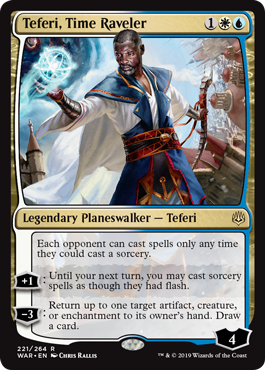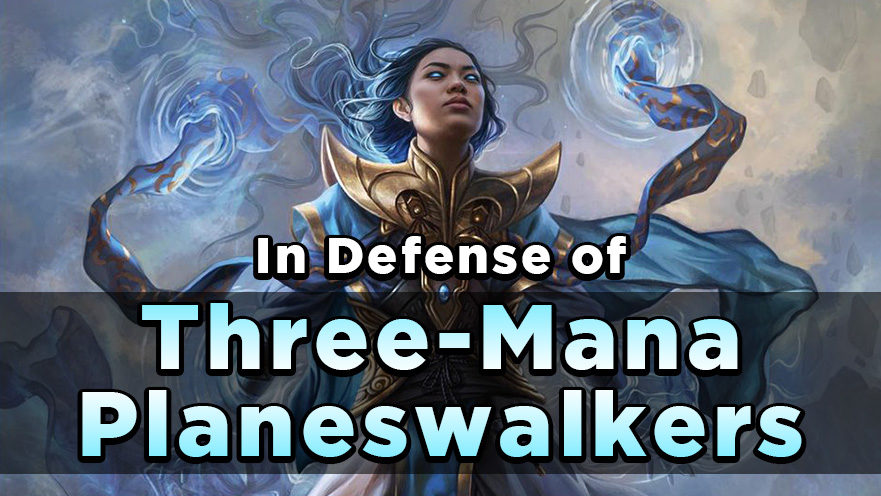Oko, Thief of Crowns appeared in 69% of decks at Mythic Championship VI. Simic-based Food was the obvious best deck going into the high-stakes event, so the elite field of competitors were highly incentivized to beat Oko any way they could. (In the end, an unprecedented majority chose to join him instead.) The Oko build of Urza combo is arguably the best deck currently in Modern. At the prestigious Eternal weekend, Oko, Thief of Crowns appeared in the winning 75 for both Legacy and Vintage. The dominance of this brand-new Planeswalker in these venerable formats is only challenged by other 2019 all-stars: Karn, the Great Creator, Narset, Parter of Veils, Wrenn and Six, and Teferi, Time Raveler.

Every format is overrun with these cards, and even players who aren’t sleeving them up must bow to their influence. All creatures and artifacts must be evaluated on their strength as 3/3 Elks, every counterspell viewed with doubt when Teferi’s about. The jokes of “just ban Planeswalkers!” draw hollow laughter, because the punchline is really how much of the audience wishes that were possible.
But Planeswalkers aren’t going away, not even the three-mana ones. Oko may have been sacrificed to satiate Standard players, Wrenn and Six banned from Legacy, and Narset restricted in Vintage. But at this point, Wizards is not making these cheap, pushed Planeswalkers by accident, and others will be released with each passing set. What’s more, this isn’t even a bad thing.
THE RULE OF THREES

The recent nuclear hot streak of busted, gameplay-restricting Planeswalkers at three mana has created the narrative that this CMC alone crosses a line. But the original Jace Beleren never wiped out a Constructed format! Even more powerful recent designs like Liliana, the Last Hope and Nissa, Voice of Zendikar didn’t lead people to gnash and wail like this. There have been six other Mythic Rare three-mana Planeswalkers printed this year which I haven’t mentioned yet, because of their comparative lack of impact. Can you even remember them all?
Clearly, there’s a right way and a wrong way to design these cards. Why is Liliana, the Last Hope so much more palatable than Oko? Both come down early and uptick to defend themselves; both reward a few turns of board control with nearly-certain victory. So, what’s the difference?
I argue that it comes down to the more proactive and narrow nature of older Planeswalkers. Liliana upticks to defend herself from creature attack, but that’s all she does. And, what’s more, she combats creatures in a specific, limited way. If you want to recur your Fulminator Mage or Baleful Strix, you’ll have to sacrifice some of that hard-won loyalty. If you tick her all the way up to seven and then she eats an Abrupt Decay, then you’ve simply gambled and lost.
GAMES WITHIN GAMES

Nearly every Planeswalker card can be looked at as creating a “subgame” when it enters play. While there are many situations where a creature or other permanent has influence on the game, active Planeswalkers consistently generate value turn by turn. The game you were playing around life totals and win conditions is superseded by “how can I beat/protect this Planeswalker.” It’s worth noting that this is a feature, not a bug. Planeswalkers were intentionally created to give Magic this kind of “objective” card, to break up the normal flow of play — and sometimes, that can be a good thing.
But a key point is how much choice a particular Planeswalker’s subgame allows the opponents who are trapped in it. You can fight Liliana, the Last Hope with creatures too large or numerous for her to shrink. If you have X/1 creatures, you can potentially hold off playing them until you find removal for her. If you have board advantage, you can even ignore Liliana and beat down her controller. An aura that says “enchanted creature gets -2/-1” is a pretty bad Magic card for 1BB, and when you’re in a position to exploit that, it feels rewarding.
Compare that to the subgame of Teferi, Time Raveler. Teferi comes down, often on an early turn or right after a sweeper, when board presence is low on both sides. He ticks down, bouncing your permanent and drawing a card to replace himself. Before you even get priority back, you are behind on every meaningful axis. You’re almost certainly stuck re-casting your bounced card (while the Teferi player develops further), and you’re under extreme pressure to commit to finishing off this lame-duck Teferi on this turn or the next.
If your opponent is in a position to exploit Teferi’s static and +1 abilities, they might defend him, eventually getting a second use of the -3 ability. Or they might let you waste a turn of attacks (you want to make sure, right?) or tap out to use removal on your turn before simply dropping the next Teferi and resetting the subgame to their further advantage.
Oko has a similar play pattern. You can’t just ignore him and beat down because the combination of food lifegain, elk blockers, and devastating downtick threat protect his controller. You can’t ignore him and go over the top because the stream of 3/3 attackers and ability to blank even expensive threats is too much pressure. And you can’t chip away at his loyalty to keep him off his dangerous abilities because he has a high starting loyalty and two abilities that increase it. And even if you answer him with Swift End the moment he comes into play, he has already generated permanent, significant advantage on top of forcing you to spend three mana and a card.
Players are not excited to play against Oko and Teferi because their subgames don’t feel like chess — they feel like Snakes and Ladders. All of your “choices” in the subgame are forced by the immense pressure these cards exert, and none of the outcomes feel like you came out ahead or “beat” the card at all. But there’s really only one way that has any relation to them costing three.
THE LAWS OF EQUIVALENT EXCHANGE

Planeswalkers have historically been more expensive and more fragile than they are now. It used to feel like a win to cut one down for 1BB, but casting Swift End on Oko leaves you decidedly behind on tempo and collateral. Planeswalkers already have a higher floor for value than creature threats: you’re guaranteed to get at least one activation on resolution, and the resource advantages most of them net you are more broadly useful than one hit of combat damage. Given these advantages, you would expect removal for Planeswalkers to be highly efficient so as to not make answering them any worse of a trade. But that is not the case.
If Planeswalkers cost as much as traditional creature threats, then they require cheap, instant-speed answers on a par with Fatal Push or Path to Exile. These answers need to be flexible enough to maindeck, and they should appear in all colors. Cards like The Elderspell could also afford to be more common, now that Planeswalkers are cheap and plentiful.
Imagine what can be done in white. Cheap “hatebear” creatures are a great complement to the color’s clunky, sorcery-speed removal; just make a few that hurt Planeswalkers. A two-mana 3/1 with “Abilities of Planeswalkers which entered play this turn cannot be activated” would challenge the ability of Planeswalkers to break up board states without support. Or in red, a 2/2 with haste and “Whenever a player activates a loyalty ability, CARD deals 2 damage to that player.” Or a green mana dork that says “Whenever you or a permanent you control becomes the target of a loyalty ability an opponent controls, create a 4/4 green Beast creature token with hexproof.”
Every color has the potential to alter the “subgame” of enemy Planeswalkers in ways specific to their identity, and attaching these to otherwise playable cards will lead to more interesting decisions on both sides.
DON’T HATE THE PLAYER, HATE THE SUBGAME
Hall of Famers often say that good interaction makes for good Magic. I believe that improving the tools to deal with three-mana ’walkers efficiently — and avoiding creating ’walkers with punishing, forced-choice subgames — will allow Wizards to continue printing these cards without the issues we’ve seen in 2019.

Tom’s fate was sealed in 7th grade when his friend lent him a pile of commons to play Magic. He quickly picked up Boros and Orzhov decks in Ravnica block and has remained a staunch white magician ever since. A fan of all Constructed formats, he enjoys studying the history of the tournament meta. He specializes in midrange decks, especially Death & Taxes and Martyr Proc. One day, he swears he will win an MCQ with Evershrike. Ask him how at @AWanderingBard, or watch him stream Magic at twitch.tv/TheWanderingBard.

